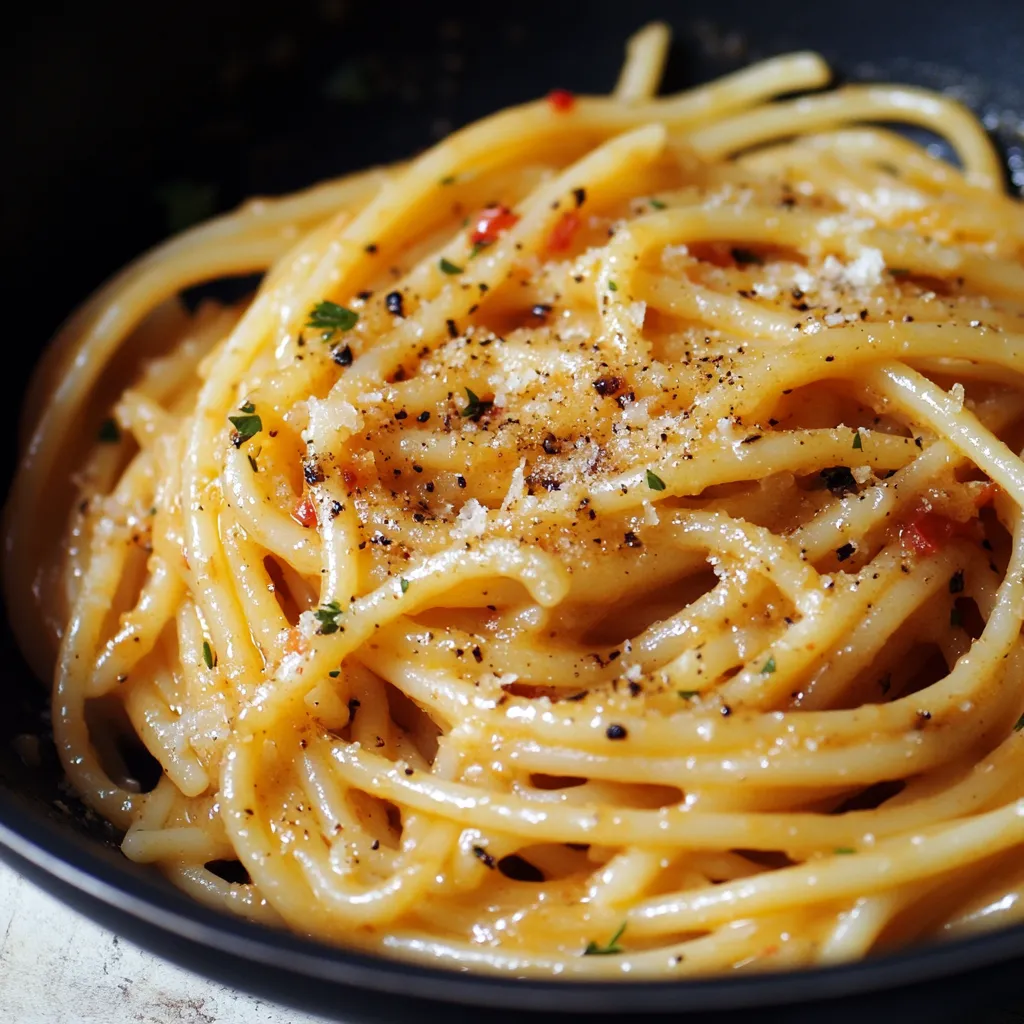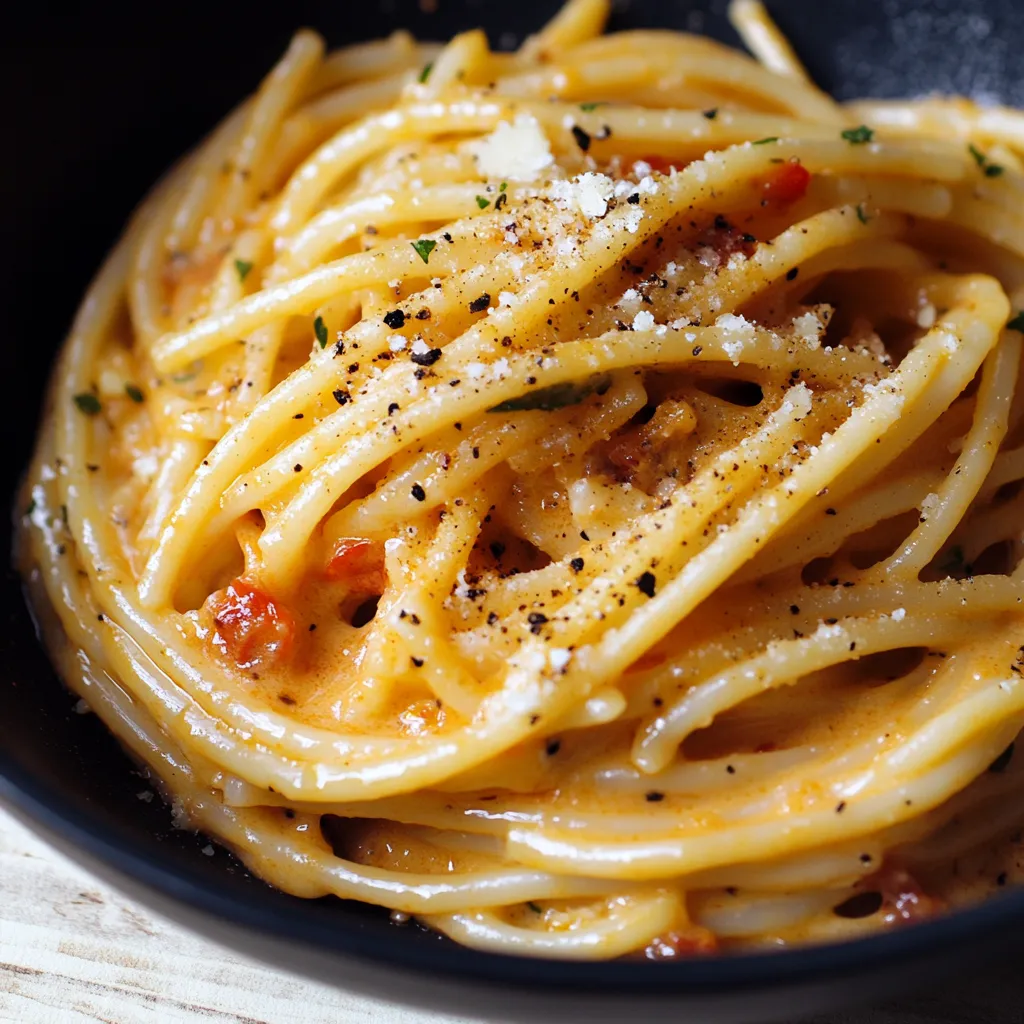 Pin it
Pin it
Garlic Chilli Cacio e Pepe elevates the humble Roman classic into something extraordinary with bold flavor additions that complement rather than overwhelm the original. This spicy variation maintains the soul-warming creaminess of traditional cacio e pepe while introducing vibrant heat from fresh chillies and aromatic depth from golden sautéed garlic. The sauce clings luxuriously to each strand of pasta, creating the perfect balance between spice, salt, and richness. Every twirl of your fork delivers an intoxicating combination that starts with peppery warmth and builds to a pleasant lingering heat that keeps you returning for another bite.
I discovered this variation during a particularly cold winter when the classic cacio e pepe needed something extra to warm both body and spirit. After experimenting with various additions, the combination of fresh garlic and chillies created magic that had my family requesting it weekly. Even my father, who typically avoids spicy foods, found himself drawn to this dish, commenting on how the heat built gradually without overwhelming the creamy cheese sauce. This recipe has become our special occasion pasta, the one guests specifically request when visiting.
Essential Italian Ingredients
- Dried spaghetti: Offers the ideal texture and surface area for capturing the creamy sauce.
- Fresh garlic cloves: Provide aromatic foundation and gentle sweetness when properly sautéed.
- Red bird's eye chillies: Deliver precise heat with bright fruity undertones.
- Kashmiri chilli powder: Adds vivid color and subtle warmth without overpowering spiciness.
- Butter: Creates necessary richness and helps emulsify the sauce.
- Shallots: Introduce delicate sweetness that balances bold flavors.
- Pecorino Romano cheese: Forms the heart of this dish with its sharp salinity and complex aged character.
- Whole black peppercorns: Deliver superior flavor when freshly toasted and ground.
- Fresh flat-leaf parsley: Brightens the finished dish and balances richness.
Pasta Perfection
- Pepper Preparation:
- Toast whole black peppercorns in a dry pan until fragrant. Grind immediately using a mortar and pestle, leaving some larger pieces for textural contrast.
- Flavor Foundation:
- Melt butter over gentle heat. Add freshly ground pepper to warm butter, creating a fragrant base.
- Aromatic Development:
- Sauté minced shallots until translucent, allowing their natural sugars to release.
- Garlic Technique:
- Add thinly sliced garlic and cook until barely golden, avoiding dark coloration that causes bitterness.
- Chilli Integration:
- Introduce fresh chillies alongside garlic, allowing their oils to infuse into the butter.
- Pasta Precision:
- Cook pasta one minute less than package instructions in heavily salted water. Reserve starchy cooking water.
- Mantecatura Mastery:
- Remove pan from heat before adding pasta water and cheese. Toss continuously to create a silky emulsion.
- Final Integration:
- Toss pasta with tongs, ensuring an even sauce coating. Adjust consistency with reserved pasta water as needed.
 Pin it
Pin it
My grandmother always insisted that patience makes the difference between good and transcendent pasta. She taught me that rushing any step compromises texture and flavor development. This dish consistently receives the highest praise at dinner parties, proving that simple ingredients treated with care can create extraordinary meals.
Roman Culinary Heritage
Cacio e pepe has been a staple of Roman cuisine for centuries. Originally created by shepherds using nonperishable ingredients, this dish remains a testament to the simplicity of Italian cooking. The addition of garlic and chilli respects traditional methods while enhancing the flavors to create something unique and memorable.
Complementary Serving Ideas
Pair with arugula salad dressed in lemon juice and olive oil for freshness. Serve with crusty sourdough bread to soak up the sauce. Enhance the meal with a chilled white wine like Frascati. Finish with limoncello for a traditional Roman dining experience.
Creative Variations
For a citrus-infused version, add lemon zest before serving. To introduce herbal complexity, incorporate fresh basil alongside parsley. For a heartier dish, add crisped pancetta before tossing the pasta.
Proper Storage
Cacio e pepe is best served immediately, as the sauce is most stable when fresh. If storing, refrigerate cooled pasta in an airtight container for up to two days. Reheat in a pan with a splash of water, stirring continuously to recreate the emulsion.
 Pin it
Pin it
One of my most treasured memories with this dish was preparing it for an Italian friend visiting from Rome. Initially skeptical about the additions, he was won over by the balance of flavors. After finishing his plate, he declared it 'respectfully innovative' and requested the recipe. This pasta perfectly blends heritage with creative expression.
Frequently Asked Questions
- → Can I adjust the spice level of this Garlic Chilli Cacio e Pepe?
- Absolutely! This recipe has three heat sources that you can adjust. For a milder version, reduce the bird's eye chillies to one or substitute with a milder pepper like jalapeño. You can also reduce the Kashmiri chilli powder to 1 teaspoon or omit it entirely. Keep the black pepper though - it's essential to the classic cacio e pepe character.
- → What can I substitute for pecorino cheese?
- Parmigiano Reggiano (parmesan) makes the best substitute for pecorino, though it has a nuttier, less sharp flavor. Aged Asiago or Manchego could also work in a pinch. Whatever you choose, make sure it's a hard, aged cheese that can be finely grated. Avoid pre-grated cheese as it contains anti-caking agents that prevent proper melting into a sauce.
- → Why is my sauce clumping instead of becoming creamy?
- Sauce clumping usually happens when the pan is too hot when adding the cheese. Make sure to turn off the heat before adding pasta water and cheese. Also, adding the cheese gradually while continuously stirring helps prevent clumping. If your sauce does clump, add a splash more pasta water and keep tossing vigorously off the heat to smooth it out.
- → What's the best pasta shape for this dish?
- Traditional cacio e pepe uses long pasta shapes like spaghetti or bucatini, which are perfect for this spicy version too. The sauce clings nicely to these shapes, and twirling the pasta helps distribute the spicy flavors. In a pinch, other long pastas like linguine or fettuccine would work well. Just avoid short shapes like penne, which won't give the same eating experience.
- → Can I make Garlic Chilli Cacio e Pepe ahead of time?
- This pasta is really best enjoyed immediately after preparing. The sauce relies on the heat of the pasta and freshly emulsified ingredients, which begin to separate as they cool. If you need to prepare components ahead, you could toast and crush the peppercorns and have your other ingredients measured and ready, but the actual cooking and sauce creation should happen just before serving.
